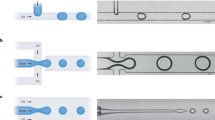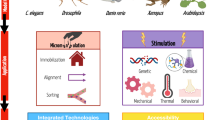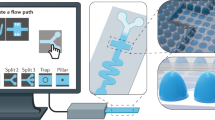Abstract
Recent years have seen considerable progress in the development of microfabricated systems for use in the chemical and biological sciences. Much development has been driven by a need to perform rapid measurements on small sample volumes. However, at a more primary level, interest in miniaturized analytical systems has been stimulated by the fact that physical processes can be more easily controlled and harnessed when instrumental dimensions are reduced to the micrometre scale. Such systems define new operational paradigms and provide predictions about how molecular synthesis might be revolutionized in the fields of high-throughput synthesis and chemical production.
This is a preview of subscription content, access via your institution
Access options
Subscribe to this journal
Receive 51 print issues and online access
$199.00 per year
only $3.90 per issue
Buy this article
- Purchase on Springer Link
- Instant access to full article PDF
Prices may be subject to local taxes which are calculated during checkout






Similar content being viewed by others
References
Wöhler, F. Grundriß der Organischen Chemie (Duncker und Humblot, Berlin, 1848).
Levenspiel, O. Chemical Reaction Engineering (Wiley & Sons, Chichester, 1999).
Nguyen, N. T. & Wu, Z. Micromixers — a review. J. Micromech. Microeng. 15, R1–R16 (2005).
Ottino, J. M., Wiggins, S. Introduction: mixing in microfluidics. Phil. Trans. R. Soc. Lond. A 362, 923–935 (2004).
Shastry, M. C. R., Luck, S. D. & Roder, H. A Continuous-flow capillary mixing method to monitor reactions on the microsecond time scale. Biophys. J. 74, 2714–2721 (1998).
Knight, J. B., Vishwanath, A., Brody, J. P. & Austin, R. H. Hydrodynamic focusing on a silicon chip: mixing nanoliters in microseconds. Phys. Rev. Lett. 80, 3863–3866 (1998).
Ottino, J. M. The mixing of fluids. Sci. Am. 260, 56–67 (1989).
Ottino, J. M. Mixing, chaotic advection, and turbulence. Ann. Rev. Fluid Mech. 22, 207–254 (1990).
Mengeaud, V., Josserand, J. & Girault, H. H. Mixing processes in a zigzag microchannel: finite element simulation and optical study. Anal. Chem. 74, 4279–4286 (2002).
Chen, H. & Meiners, J. C. Topologic mixing on a microfluidic chip. Appl. Phys. Lett. 84, 2193–2195 (2004).
Liu, R. H. et al. Passive mixing in a three-dimensional serpentine microchannel. J. Microelectromech. Syst. 9, 190–197 (2000).
Stroock, A. D. et al. Chaotic mixer for microchannels. Science 295, 647–651 (2002).
Biddiss, E., Erickson, D. & Li, D. Q. Heterogeneous surface charge enhanced micromixing for electrokinetic flows. Anal. Chem. 76, 3208–3213 (2004).
Burns, M. A. et al. An integrated nanoliter DNA analysis device. Science 282, 484–487 (1998).
Taniguchi, T., Torii, T. & Higuchi, T. Chemical reactions in microdroplets by electrostatic manipulation of droplets in liquid media. Lab Chip 2, 19–23 (2002).
Bringer, M. R., Gerdts, C. J., Song, H., Tice, J. D. & Ismagilov, R. F. Microfluidic systems for chemical kinetics that rely on chaotic mixing in droplets. Phil. Trans. R. Soc. Lond. A 362, 1087–1104 (2004).
Tice, J. D., Song, H., Lyon, A. D. & Ismagilov, R. F. Formation of droplets and mixing in multiphase microfluidics at low values of the Reynolds and the capillary numbers. Langmuir 19, 9127–9133 (2003).
Song, H., Tice, J. D. & Ismagilov, R. F. A microfluidic system for controlling reaction networks in time. Angew. Chem. Int. Edn 42, 768–772 (2003).
Song, H. & Ismagilov, R. F. Millisecond kinetics on a microfluidic chip using nanoliters of reagents. J. Am. Chem. Soc. 125, 14613–14619 (2003).
Chambers, R. D. & Spink, R. C. H. Microreactors for elemental fluorine. Chem. Commun. 883–884 (1999).
Chambers, R. D., Holling, D., Spink, R. C. H. & Sandford, G. Elemental fluorine Part 13. Gas–liquid thin film microreactors for selective direct fluorination. Lab Chip 1, 132–137 (2001).
Chambers, R. D., Fox, M. A. & Sandford, G. Elemental fluorine Part 18. Selective direct fluorination of 1,3-ketoesters and 1,3-diketones using gas/liquid microreactor technology. Lab Chip 5, 1132–1139 (2005).
Mitchell, M. C., Spikmans, V. & deMello, A. J. Microchip-based synthesis and analysis: control of multicomponent reaction products and intermediates. Analyst 126, 24–27 (2001).
Kawaguchi, T., Miyata, H., Ataka, K., Mae, K. & Yoshida, J. Room-temperature Swern oxidations by using a microscale flow system. Angew. Chem. Int. Edn 44, 2413–2416 (2005).
Salimi-Moosavi, H., Tang, T. & Harrison, D. J. Electroosmotic pumping of organic solvents and reagents in microfabricated reactor chips. J. Am. Chem. Soc. 119, 8716–8717 (1997).
Wootton, R. C. R., Fortt, R. & de Mello, A. J. On chip generation and reaction of unstable intermediates — monolithic nanoreactors for diazonium chemistry: azo dyes. Lab Chip 2, 5–7 (2002).
Ducry, L. & Roberge, D. M. Controlled autocatalytic nitration of phenol in a microreactor. Angew. Chem. 117, 8186–8189 (2005).
Iles, A., Fortt, R. & de Mello, A. J. Thermal optimisation of the Reimer–Tiemann reaction using thermochromic liquid crystals on a microfluidic reactor. Lab Chip 5, 550–554 (2005).
Miller, P. W. et al. Rapid formation of amides via carbonylative coupling reactions using a microfluidic device. Chem. Commun. 546–548 (2006).
Besser, R. S., Ouyang, X. & Surangalikar, H. Hydrocarbon hydrogenation and dehydrogenation reactions in microfabricated catalytic reactors. Chem. Eng. Sci. 58, 19–26 (2003).
Greenway, G. M., Haswell, S. J., Morgan, D. O., Skelton, V. & Styring, P. The use of a novel microreactor for high throughput continuous-flow organic synthesis. Sens. Actuators B 63, 153–158 (2000).
Schwesinger, N., Pieper, G. & Wurziger, H. Method for carrying out a metathesis reaction of unsaturated organic compounds. World Patent WO0170387 (2001).
Lu, H., Schmidt, M. A. & Jensen, K. F. Photochemical reactions and on-line UV detection in microfabricated reactors. Lab Chip 1, 22–28 (2001).
Wootton, R. C. R., Fortt, R. & de Mello, A. J. A microfabricated nanoreactor for safe, continuous generation and use of singlet oxygen. Org. Proc. Res. Dev. 6, 187–189 (2002).
Watts, P. & Haswell, S. J. Continuous-flow reactors for drug discovery. Drug Discov. Today 8, 586–593 (2003).
Jhähnisch, K., Hessel, V., Löwe, H. & Baerns, M. Chemistry in microstructured reactors. Angew. Chem. Int. Edn 43, 406–446 (2004).
Brivio, M., Verboom, W. & Reinhoudt, D. N. Miniaturized continuous-flow reaction vessels: influence on chemical reactions. Lab Chip 6, 329–344 (2006).
Watts, P. & Haswell, S. J. The application of microreactors for small-scale organic synthesis. Chem. Eng. Technol. 28, 290–301 (2005).
Jensen, K. F. Microreaction engineering — is small better? Chem. Eng. Sci. 56, 293–303 (2001).
Geysen, H. M., Schoenen, F., Wagner, D. & Wagner, R. Combinatorial compound libraries for drug discovery: an ongoing challenge. Nature Rev. Drug Discov. 2, 222–230 (2003).
Dittrich, P. S. & Manz, A. Lab-on-a-chip: microfluidics in drug discovery Nature Rev. Drug Discov. 5, 211–218 (2006).
Mitchell, M. C., Spikmans, V., Manz, A. & deMello, A. J. Microchip-based synthesis and total analysis system (µSYNTAS): chemical microprocessing for generation and analysis of compound libraries. J. Chem. Soc. Perkin Trans. 1 514–518 (2001).
Garcia-Egido, E., Wong, S. Y. F. & Warrington, B. H. A Hantzsch synthesis of 2-aminothiazoles performed in a heated microreactor system. Lab Chip 2, 31–33 (2002).
Fernandez-Suarez, M., Wong, S. Y. F. & Warrington, B. H. Synthesis of a three-member array of cycloadducts in a glass microchip under pressure driven flow. Lab Chip 2, 170–174 (2002).
Garcia-Egido, E., Spikmans, V., Wong, S. Y. F. & Warrington, B. H. Synthesis and analysis of combinatorial libraries performed in an automated micro reactor system. Lab Chip 3, 73–76 (2003).
Kikutani, Y. et al. Glass microchip with three-dimensional microchannel network for 2 × 2 parallel synthesis. Lab Chip 2, 188–192 (2002).
Kobayashi, J. et al. A microfluidic device for conducting gas–liquid–solid hydrogenation reactions. Science 304, 1305–1308 (2004).
Fredrickson, C. K. & Fan, Z. H. Macro-to-micro interfaces for microfluidic devices. Lab Chip 4, 526–533 (2004).
Alivisatos, A. P. Semiconductor clusters, nanocrystals, and quantum dots. Science 271, 933–937 (1996).
LaMer, V. K. & Dinegar, R. H. Theory, production and mechanism of formation of monodispersed hydrosols. J. Am. Chem. Soc. 72, 4847–4854 (1950).
Murray, C. B., Kagan, C. R. & Bawendi, M. G. Synthesis and characterization of monodisperse nanocrystals and close-packed nanocrystal assemblies. Annu. Rev. Mater. Sci. 30, 545–610 (2000).
deMello, J. & deMello, A. Microscale reactors: nanoscale products. Lab Chip 4, 11N–15N (2004).
Edel, J. B., Fortt, R., deMello, J. C. & deMello, A. J. Microfluidic routes to the controlled production of nanoparticles. Chem. Commun. 1136–1137 (2002).
Hung, L. -H. et al. Alternating droplet generation and controlled dynamic droplet fusion in microfluidic device for CdS nanoparticle synthesis. Lab Chip 6, 174–178 (2006).
Krishnadasan, S., Tovilla, J., Vilar, R., deMello, A. J. & deMello, J. C. On-line analysis of CdSe nanoparticle formation in a continuous-flow chip-based microreactor. J. Mater. Chem. 14, 2655–2660 (2004).
Yen, B. K. H., Stott, N. E., Jensen, K. F. & Bawendi, M. G. A continuous-flow microcapillary reactor for the preparation of a size series of CdSe nanocrystals. Adv. Mater. 15, 1858–1862 (2003).
Song, Y., Kumar, C. S. S. R. & Hormes, J. Synthesis of Pd nanoparticles using a continuous-flow polymeric micro reactor. J. Nanosci. Nanotech. 4, 788–793 (2004).
He, S. et al. Effects of interior wall on continuous fabrication of silver nanoparticles in microcapillary reactor. Chem. Lett. 34, 748–749 (2005).
Lin, X. Z., Terepka, A. D. & Yang, H. Synthesis of silver nanoparticles in a continuous-flow tubular microreactor. Nano Lett. 4, 2227–2232 (2004).
Wagner, J., Kirner, T., Mayer, G., Albert, J. A. & Köhler, J. M. Generation of metal nanoparticles in a microchannel reactor. Chem. Eng. J. 101, 251–260 (2004).
Song, Y. et al. Investigations into sulfobetaine-stabilized Cu nanoparticle formation: toward development of a microfluidic synthesis. J. Phys. Chem. B 109, 9330–9338 (2005).
Wang, H., Nakamura, H., Uehara, M., Miyazaki, M. & Maeda, H. Preparation of titania particles utilizing the insoluble phase interface in a microchannel reactor. Chem. Commun. 1462–1463 (2002).
Wang, H. et al. Continuous synthesis of CdSe–ZnS composite nanoparticles in a microfluidic reactor. Chem. Commun. 48–49 (2004).
Shestopalov, I., Tice, J. D. & Ismagilov, R. F. Multi-step synthesis of nanoparticles performed on millisecond time scale in a microfluidic droplet-based system. Lab Chip 4, 316–321 (2004).
Chan, E. M., Alivisatos, A. P. & Mathies, R. A. High-temperature microfluidic synthesis of CdSe nanocrystals in nanoliter droplet. J. Am. Chem. Soc. 127, 13854–13861 (2005).
Yen, B. K. H., Günther, A., Schmidt, M. A., Jensen, K. F. & Bawendi, M. G. A microfabricated gas–liquid segmented flow reactor for high-temperature synthesis: the case of CdSe quantum dots. Angew. Chem. Int. Edn 44, 5447–5451 (2005).
Millman, J. R., Bhatt, K. H., Prevo, B. G. & Velev, O. D. Anisotropic particle synthesis in dielectrophoretically controlled microdroplet reactors. Nature Mater. 4, 98–102 (2004).
Lagally, E. T. & Mathies, R. A. Integrated genetic analysis microsystems. J. Phys. D 37, R245–R261 (2004).
Beebe, D. J., Mensing, G. A. & Walker, G. M. Physics and applications of microfluidics in biology. Annu. Rev. Biomed. Eng. 4, 261–286 (2002).
Auroux, P.-A., Koç, Y., deMello, A., Manz, A. & Day, P. J. R. Miniaturised nucleic acid analysis. Lab Chip 4, 534–546 (2004).
Jakeway, S. C., de Mello, A. J. & Russell, E. Miniaturized total analysis systems for biological analysis. Fresenius J. Anal. Chem. 366, 525–539 (2000).
Mullis, K. B. et al. Specific enzymatic amplification of DNA in vitro: the polymerase chain reaction. Cold Spring Harb. Symp. Quant. Biol. 51, 263–273 (1986).
Oda, R. P. et al. Infrared-mediated thermocycling for ultrafast polymerase chain reaction amplification of DNA. Anal. Chem. 70, 4361–4368 (1998).
Fermér, C., Nilsson, P. & Larhed, M. Microwave-assisted high-speed PCR. Eur. J. Pharm. Sci. 18, 129–132 (2003).
Hu, G. et al. Electrokinetically controlled real-time polymerase chain reaction in microchannel using Joule heating effect. Anal. Chim. Acta 557, 146–151 (2006).
Woolley, A. T. et al. Functional integration of PCR amplification and capillary electrophoresis in a microfabricated DNA analysis device. Anal. Chem. 68, 4081–4086 (1996).
Krishnan, M., Ugaz, V. M. & Burns, M. A. PCR in a Rayleigh–Benard convection cell. Science 298, 793 (2003).
Kopp, M. U., deMello, A. J. & Manz, A. Chemical amplification: continuous-flow PCR on a chip. Science 280, 1046–1048 (1998).
Obeid, P. J., Christopoulos, T. K., Crabtree, H. J. & Backhouse, C. J. Microfabricated device for DNA and RNA amplification by continuous-flow polymerase chain reaction and reverse transcription-polymerase chain reaction with cycle number selection. Anal. Chem. 75, 288–295 (2003).
Marcus, J. S., Anderson, W. F. & Quake, S. R. Parallel picoliter RT-PCR assays using microfluidics. Anal. Chem. 78, 956–958 (2006).
Liu, R. H., Yang, J., Lenigk, R., Bonanno, J. & Grodzinski, P. Self-contained, fully integrated biochip for sample preparation, polymerase chain reaction amplification, and DNA microarray detection. Anal. Chem. 76, 1824–1831 (2004).
Lagally, E. T. et al. Integrated portable genetic analysis microsystem for pathogen/infectious disease detection. Anal. Chem. 76, 3162–3170 (2004).
Blazej, R. G., Kumaresan, P. & Mathies, R. A. Microfabricated bioprocessor for integrated nanoliter-scale Sanger DNA sequencing. Proc. Natl Acad. Sci. USA 103, 7240–7245 (2006).
Schwarz, M. A. & Hauser, P. C. Recent developments in detection methods for microfabricated analytical devices. Lab Chip 1, 1–6 (2001).
Dittrich, P. S. & Manz, A. Single-molecule fluorescence detection in microfluidic channels — the holy Grail in µTAS? Anal. Bioanal. Chem. 382, 1771–1782 (2005).
Dertinger, S. K. W., Chiu, D. T., Jeon, N. L. & Whitesides, G. M. Generation of gradients having complex shapes using microfluidic networks. Anal. Chem. 73, 1240–1246 (2001).
Jeon, N. L. et al. Neutrophil chemotaxis in linear and complex gradients of interleukin-8 formed in a microfabricated device. Nature Biotechnol. 20, 826–830 (2002).
Mao, H., Yang, T. & Cremer, P. S. A microfluidic device with a linear temperature gradient for parallel and combinatorial measurements. J. Am. Chem. Soc. 124, 4432–4435 (2002).
Cabrera, C. R., Finlayson, B. & Yager, P. Formation of natural pH gradients in a microfluidic device under flow conditions: model and experimental validation. Anal. Chem. 73, 658–666 (2001).
Ratner, D. M. et al. Microreactor-based reaction optimization in organic chemistry — glycosylation as a challenge. Chem. Commun. 578–580 (2005).
Leung, S. -A., Winkle, R. F., Wootton, R. C. R. & deMello, A. J. A method for rapid reaction optimisation in continuous-flow microfluidic reactors using online Raman spectroscopic detection. Analyst 130, 46–52 (2005).
Hatakeyama, T., Chen, D. L. & Ismagilov, R. F. Microgram-scale testing of reaction conditions in solution using nanoliter plugs in microfluidics with detection by MALDI-MS. J. Am. Chem. Soc. 128, 2518–2519 (2006).
Chambers, R. D. et al. Elemental fluorine Part 16. Versatile thin-film gas–liquid multi-channel microreactors for effective scale-out. Lab Chip 5, 191–198 (2005).
Lee, C. C. et al. Multistep synthesis of a radiolabeled imaging probe using integrated microfluidics. Science 16, 1793–1796 (2005).
Kikutani, Y. et al. Pile-up glass microreactor. Lab Chip 2, 193–196 (2002).
Pennemann, H., Watts, P., Haswell, S. J., Hessel, V. & Lowe, H. Benchmarking of microreactor applications. Org. Proc. Res. Dev. 8, 422–439 (2004).
Acknowledgements
I would like to thank C. deMello and T. deMello for help in preparing the manuscript.
Author information
Authors and Affiliations
Ethics declarations
Competing interests
The author declares no competing financial interests.
Additional information
Author Information Reprints and permissions information is available at npg.nature.com/reprintsandpermissions.
Rights and permissions
About this article
Cite this article
deMello, A. Control and detection of chemical reactions in microfluidic systems. Nature 442, 394–402 (2006). https://doi.org/10.1038/nature05062
Published:
Issue Date:
DOI: https://doi.org/10.1038/nature05062
This article is cited by
-
Gene knockdown in HaCaT cells by small interfering RNAs entrapped in grapefruit-derived extracellular vesicles using a microfluidic device
Scientific Reports (2023)
-
Analysis of interfacial mixing zone and mixing index in microfluidic channels
Microfluidics and Nanofluidics (2023)
-
Numerical Simulation of Mixing in Active Micromixers Using SPH
Transport in Porous Media (2023)
-
Mixing-Induced Bimolecular Reactive Transport in Rough Channel Flows: Pore-Scale Simulation and Stochastic Upscaling
Transport in Porous Media (2023)
-
Mixing Process and Flow Structure in Electrokinetic Micromixer with Rough Walls- A Study on Rough Geometry
Experimental Techniques (2023)
Comments
By submitting a comment you agree to abide by our Terms and Community Guidelines. If you find something abusive or that does not comply with our terms or guidelines please flag it as inappropriate.



